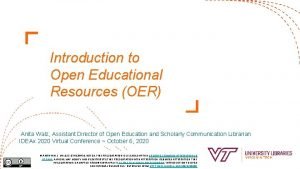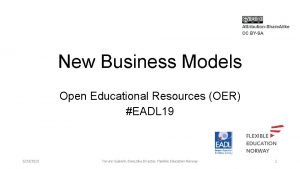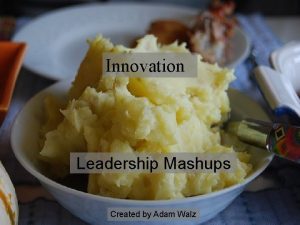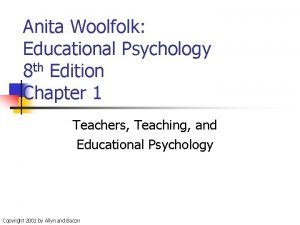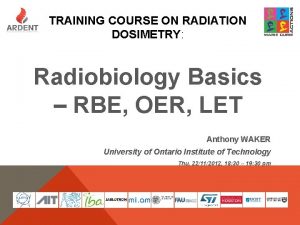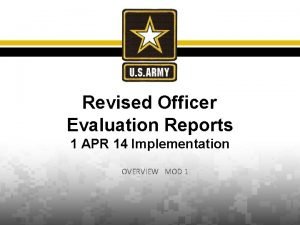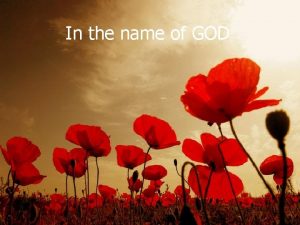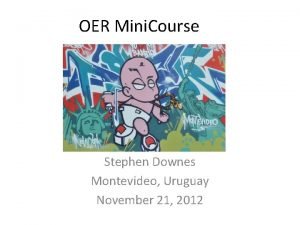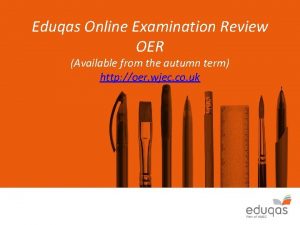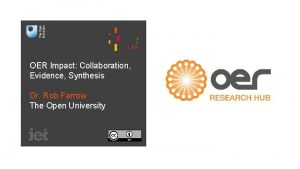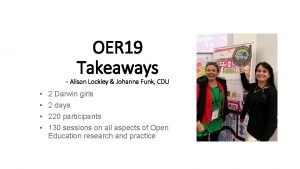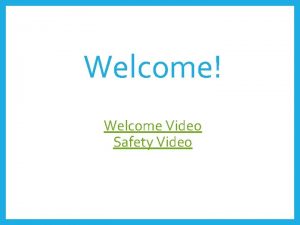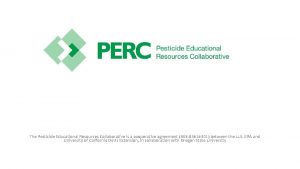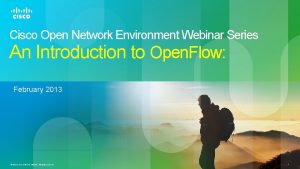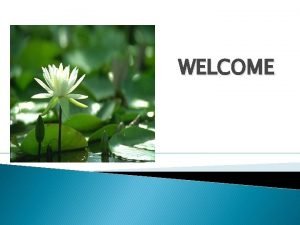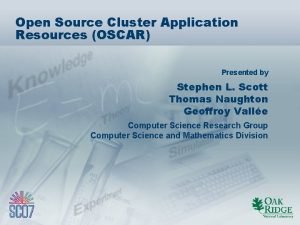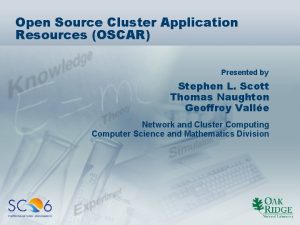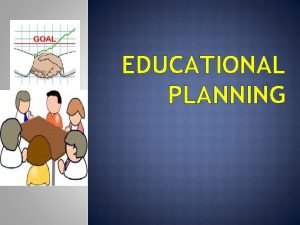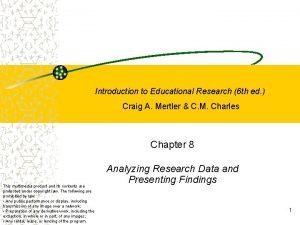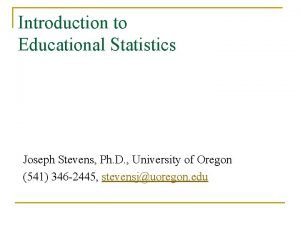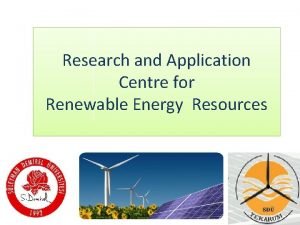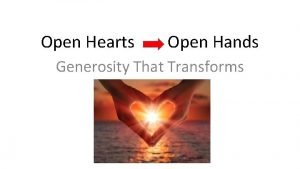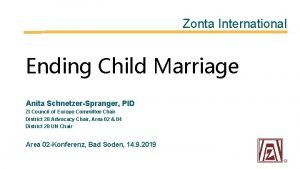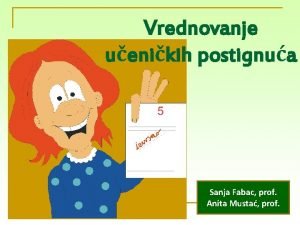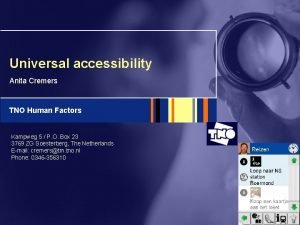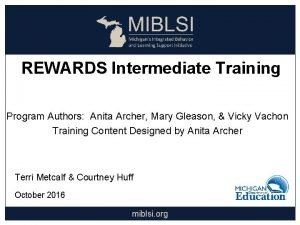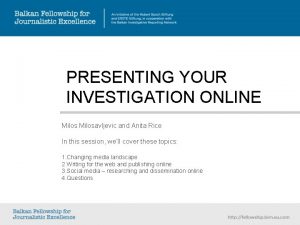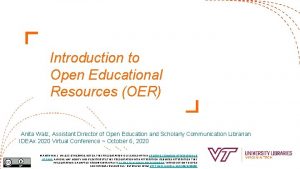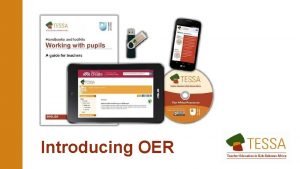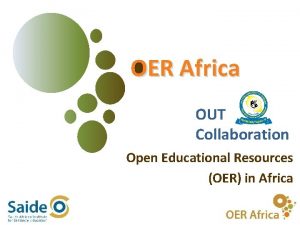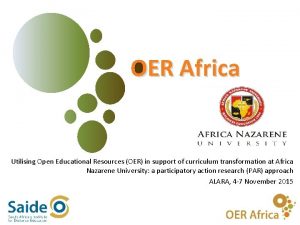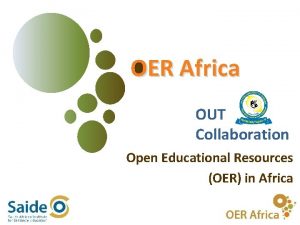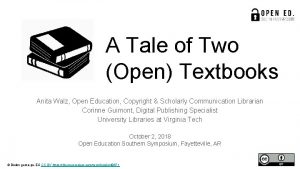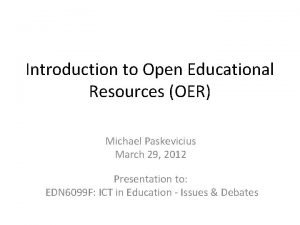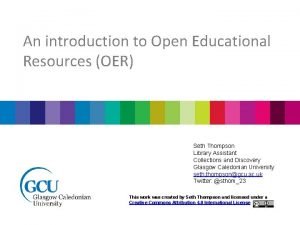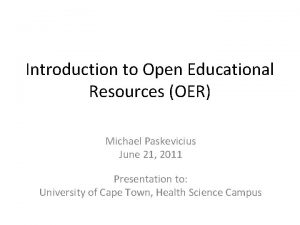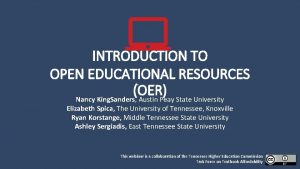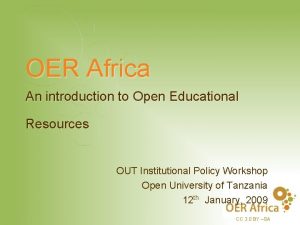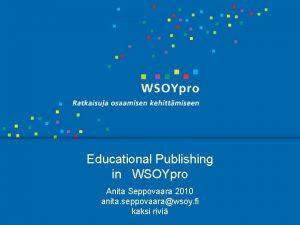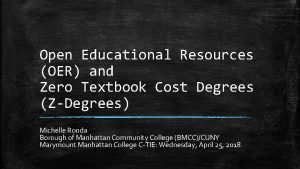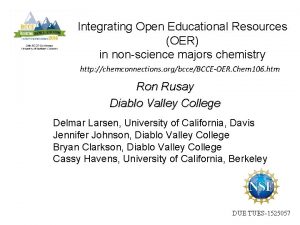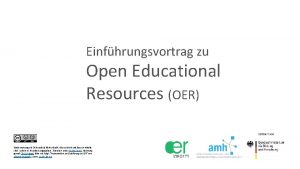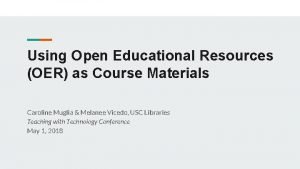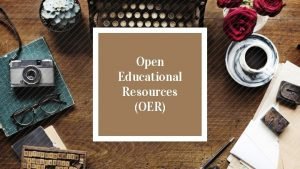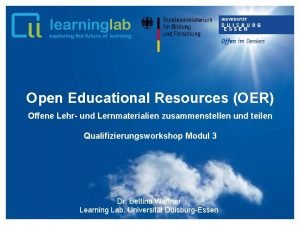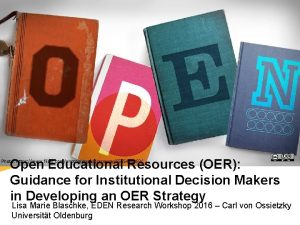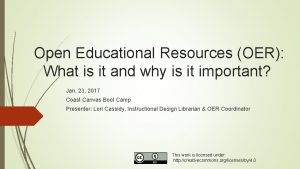Introduction to Open Educational Resources OER Anita Walz


































- Slides: 34

Introduction to Open Educational Resources (OER) Anita Walz, Assistant Director of Open Education and Scholarly Communication Librarian IDEAx 2020 Virtual Conference ~ October 6, 2020 © ANITA WALZ. UNLESS OTHERWISE NOTED, THIS PRESENTATION IS LICENSED WITH A CREATIVE COMMONS ATTRIBUTION 4. 0 LICENSE. ANYONE MAY MODIFY AND REDISTRIBUTE THIS PRESENTATION WITH ATTRIBUTION. REQUIRED ATTRIBUTION: THIS PRESENTATION IS ADAPTED FROM © ANITA WALZ’S CC BY 4. 0 LICENSED PRESENTATION “INTRODUCTION TO OPEN EDUCATIONAL RESOURCES” RETRIEVED FROM HTTP: //HDL. HANDLE. NET/10919/100283

What you wanted to know. . . d l u o w e s l e t Wha ? w o n k o t e k i l you

https: //paulgstacey. files. wordpress. com/2017/11/landscapeofopenstacey. jpg

Discussion: On a scale of 1 to 5, how familiar are you with open educational resources (OER)? (1=not familiar; 5=very familiar)

Open Educational Resources (OER) are freely and publicly available teaching, learning, and research resources that reside in the public domain or have been released under an intellectual property license that permits their free use, reuse, modification, and sharing with others. They include full courses, course materials, modules, textbooks, streaming videos, tests, software, and any other tools, materials, or techniques used to support access to knowledge. - Hewlett Foundation

Public Domain - Copyright has expired (pre-1924) - Was never eligible for copyright - Clearly donated to the Public Domain - NOT the same as “free online” Intellectual property license permitting free use, reuse, modification, and sharing

Examples https: //guides. lib. vt. ed u/oer Textbooks: https: //guides. lib. vt. edu/oer/opentextbooks Figures and illustrations: https: //guides. lib. vt. edu/oer/images Simulations: https: //guides. lib. vt. edu/oer/labs Homework: https: //guides. lib. vt. edu/oer/homework

Creative Commons licenses can help you to: - Share original works by making them more useable to others. - Legally (and easily) incorporate CC-licensed works authored by others in your own work

Added bonuses: Using CC-licenses may: - Extend your impact, audience and the reach of your work - Start (and build on) a virtuous cycle of sharing - Save money for your students and other readers

Discussion: Have you heard of Creative Commons licenses before?


Not all CC-licenses allow derivatives NOT OER These licenses (ND) are not “open licenses” as they do not allow derivatives.


BY (Attribution) NC (Non. Commercial) SA(Share. Alike) ND(No. Derivatives)

Read more here: https: //creativecommons. org/licenses OER definition: http: //www. hewlett. org/strategy/open-educational-resources/ No known copyright Donated to the public domain (and marked as such) Creative Commons Attribution License (CC BY) Creative Commons Attribution Share-Alike License (CC BY SA) Creative Commons Attribution Non-Commerical License (CC BY NC) Creative Commons Attribution Non-Commercial Share. Alike (CC BY NC SA)


https: //creativecommons. org/licenses/by/2. 0/legalcode

What can I do with OER? Retain - Make, own, and control copies of the content (store, manage, download, duplicate) Reuse - Use the content in various ways (in class, study group, extension, journal article, on the radio, in a video, website etc. ) Revise - Adapt, modify, alter the content (reformat or translate) Remix - Combine revised or original content with other materials to create something new (i. e. mashup) Redistribute - Share copies of original content, revised content, or remixes with others Source: This material is based on original writing by David Wiley, which was published freely under a Creative Commons Attribution 4. 0 license at http: //opencontent. org/definition

Questions?

Best practices for creating & sharing OER Evaluate Mark License EMLS Share © Anita Walz. Unless otherwise noted, this presentation is licensed with a Creative Commons Attribution 4. 0 license. Anyone may modify and redistribute this presentation with attribution. Required attribution: This presentation is adapted from © Anita Walz’s CC BY 4. 0 licensed presentation “Introduction to Open Educational Resources” Public domain image: https: //pixabay. com/en/tree-elm-tree-leaf-green-1484370/ retrieved from http: //hdl. handle. net/10919/100283

Evaluate - Did I create (and still own) all of the content in the item? - If not, do I have permission for my use of third-party content? - CC-licensed content - requires attribution Public domain content (pre-1924, © expired, or U. S. Government content*) Written permission from the author for your specific use(s)** Fair use (with an informed Fair Use analysis***) * Public Domain in the U. S. -- Works of a U. S. Government employee within the scope of their official duties What is the Public Domain? http: //fairuse. stanford. edu/overview/public-domain/welcome ** Some permission letters request permission to release the in-copyright work under the same open license as the overall work. *** For more information see https: //librarycopyright. net/resources/fairuse/index. php EMLS

Mark 3 rd party content within the document Permission granted by: - Creative Commons license Public domain (not in copyright) Author-granted permission (preferably in writing)** Fair Use (with an informed fair use analysis) EMLS

Creative Commons example EMLS

Creative Commons example Attribution is always required when using CClicensed materials. © David Lenker Strawberry CC BY 2. 0 EMLS Best practice for attributing CC-licensed materials: https: //wiki. creativecommons. org/wiki/Best_practices_for_attribution

Creative Commons example © David Lenker Strawberry CC BY 2. 0 Attribution is always required when using CClicensed materials. © David Lenker Strawberry CC BY 2. 0 Source: https: //creativecommons. org/licenses/by/4. 0/ Best practice for attributing CC-licensed materials: https: //wiki. creativecommons. org/wiki/Best_practices_for_attribution EMLS

Public domain example Citations are good scholarly practice. Attribution of public domain works is not legally required. Poissons, Ecrevisses et Crabes (1719). Retrieved from: http: //publicdomainreview. org/collections/images-from-the-earliestknown-colour-book-on-fish-1754 [Public domain] About the Public Domain: http: //guides. lib. vt. edu/oer/PD More info on finding Public Domain works: http: //publicdomainreview. org/guide-to-finding-interesting-public-domain-works-online/ EMLS

Author permission example The permission granter may require a particular statement. Citation is good scholarly practice. EMLS

Mark 3 rd party content within the document - Creative Commons Example: © David Lenker Strawberry CC BY 2. 0 - Public Domain Example: Poissons, Ecrevisses et Crabes (1719). Retrieved from: http: //publicdomainreview. org/collections/images-from-the-earliest-known-colour-book-onfish-1754 [Public domain] - Permission Example: © Mark Perry All Rights Reserved. Used with Permission EMLS

License Example: © My. Name, Publication Year. Unless otherwise noted, licensed with a Creative Commons Attribution License 4. 0 EMLS Marking CC licensed works to be Machine Readable: https: //wiki. creativecommons. org/wiki/Marking_Works_Technical

Share in your usual places: - In print - On your website Share to avoid eventual broken links and so that others can find your work: - VTech. Works (VT’s institutional repository) https: //vtechworks. lib. vt. edu (Google crawls) - Disciplinary repositories (contact your professional society) - Open repositories: OERCommons http: //www. oercommons. org MERLOT https: //www. merlot. org Open Textbook Library https: //open. umn. edu/opentextbooks/Submit. aspx - More platforms for creating and sharing: http: //hdl. handle. net/10919/76739 Tell people about your work: - Social media channels: Twitter, Facebook, Listservs - University communication channels & news services - Tell your colleagues: Face to face EMLS

Best practices for creating & sharing OER Evaluate Mark License Share Public domain images: https: //pixabay. com/en/tree-elm-tree-leaf-green-1484370/ EMLS

Finding OER, Creative Commons & Public Domain Resources Google Advanced Search (“Usage Rights” filter) Images, music, media & video: https: //search. creativecommons. org Open (OER) Textbooks: https: //open. umn. edu/opentextbooks Interactive Simulations: https: //phet. colorado. edu And more: http: //guides. lib. vt. edu/oer

Services offered by the University Libraries - Consultations & Referrals: Where do I start? Who can help me? - Copyright, Creative Commons/Open Licensing consultations - Assistance locating & adapting openly licensed content - VTech. Works Institutional Repository - Open Textbook Publishing - Hosting of Open Journals and Open Conference Proceeding - Open Education Initiative Faculty Grants for development of openly licensed learning resources - https: //guides. lib. vt. edu/oer/grants © Anita Walz. This presentation is licensed with a Creative Commons Attribution 4. 0 license. Anyone may modify and redistribute this presentation with attribution. Required attribution: This presentation is adapted from © Anita Walz’s CC BY 4. 0 licensed presentation “Introduction to Open Educational Resources” retrieved from http: //hdl. handle. net/10919/100283

Thank you and discussion Anita Walz arwalz@vt. edu @arwalz
 Anita walz
Anita walz Open educational resources
Open educational resources Walz tanec
Walz tanec Adam walz
Adam walz Woolfolk educational psychology
Woolfolk educational psychology 영국 beis
영국 beis Oer radiation
Oer radiation Army leadership requirement model
Army leadership requirement model Particulate radiation
Particulate radiation Oer mini
Oer mini Oer eduqas
Oer eduqas Oer world map
Oer world map Alison lockley
Alison lockley Kyrene educational resources
Kyrene educational resources Pesticide educational resources collaborative
Pesticide educational resources collaborative Transformation process
Transformation process Fixed resources examples
Fixed resources examples Renewable vs nonrenewable resources worksheet
Renewable vs nonrenewable resources worksheet Cisco open network environment resources
Cisco open network environment resources Meaning of grass
Meaning of grass Open source cluster application resources
Open source cluster application resources Open source cluster application resources
Open source cluster application resources Introduction of educational planning
Introduction of educational planning Introduction to educational research mertler
Introduction to educational research mertler Introduction to educational statistics
Introduction to educational statistics Human resource management lecture chapter 1
Human resource management lecture chapter 1 Introduction about energy resources
Introduction about energy resources On delay timer coil symbol
On delay timer coil symbol Open hearts open hands
Open hearts open hands Anita schnetzer
Anita schnetzer Dr sanja mustač
Dr sanja mustač Anita cremers
Anita cremers Phonics for reading anita archer
Phonics for reading anita archer Anita forsyth
Anita forsyth Anita rice
Anita rice
